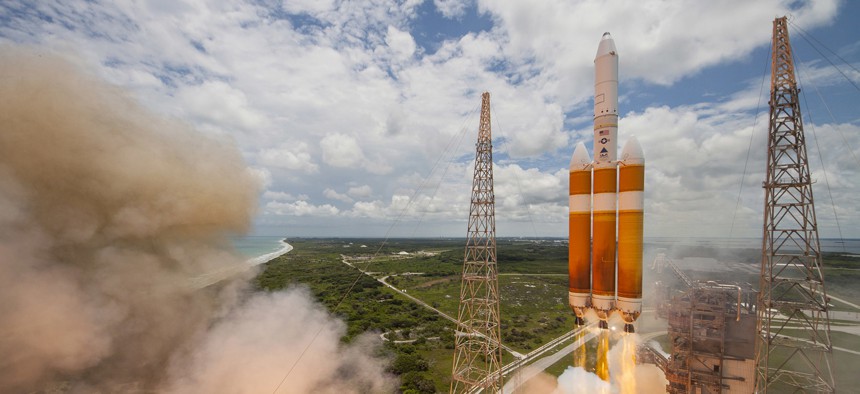
A United Launch Alliance Delta IV-Heavy rocket lifts off from Space Launch Complex 37B at Cape Canaveral Air Force Station, Florida. ULA
Space Force Clears Senate Committee After House Attempt to Stall
The Senate Armed Services Committee’s legislation “greatly increases the odds that we end up with some sort of a Space Force,” one expert says.
One week after a House subcommittee rejected new funding for President Trump’s new Space Force, the Senate Armed Services Committee voted in favor of the new service branch for the U.S. military, but scaled back some of the administration’s proposal.
Senior committee aides speaking to reporters on Thursday were short on details, but the move marks the first time a Senate panel has voted to support a separate service for space. In the same measure, senators also called for an overhaul of how the military buys satellites and launch services.
“I think we’ve got a really good path ahead for not only a U.S. Space Force, but space acquisition in the long term,” a senior committee aide said Thursday after the Senate panel finished its review of the fiscal 2020 National Defense Authorization Act, or NDAA.
The development “greatly increases the odds that we end up with some sort of a Space Force at the end of the day,” said Todd Harrison, a space and budget expert with the Center for Strategic and International Studies. “It’s clearly not a done deal though.”
Initially, the new service branch would include only Air Force personnel. For now, Army and Navy space professionals would remain in their services, and the bill prohibits the Defense Department from adding additional military or civilian personnel to stand up Space Force, according to a summary of the committee’s recommendations.
“I think the Senate is putting guardrails on this so it doesn’t go way off track and you end up with a Space Force that didn’t get all of the personnel transferred over and so it’s weak and ineffective,” said Harrison said. “They’re putting in provisions that help prevent that from happening.”
Initially, the four-star general in charge of U.S. Space Command, a new unified combatant command, would lead the Space Force. There are currently 10 combatant commands, including Strategic Command, for nuclear forces, and Special Operations Command, for elite troops from all military service branches. The top Space Command general would report to the Air Force chief of staff.
After one year, the positions would separate into two four-star billets: one general would lead Space Force as its chief of staff, and the other general would command U.S. Space Command. At that point, the Space Force chief would become a member of the Joint Chiefs of Staff, alongside the chiefs of the Army, Navy, Air Force, Marines, and National Guard. Committee aids said the Marine Corps commandant position also was not initially part of the Joint Chiefs of Staff when that service was created.
“I think it’s responsible to take this thing at a pace that makes sense,” the senior committee aide said. “We give them a year to get this all together and stood up and figure it out. They may want to tweak something within that year.”
For civilian leadership, the legislation does not include a new Air Force undersecretary for space, which was a key position inside the Pentagon’s proposal. Instead, the Senate panel recommends creating an assistant secretary of defense for space policy within the Office of the Secretary of Defense, separate from the service branches.
For buying power, the Senate panel calls for eliminating an existing senior civilian position at the Pentagon (the principal assistant to the secretary of the Air Force for space), and replacing it with an equal-level position that would oversee all space acquisition.
The committee made a number of space acquisition recommendations “to try to figure out how to duplicate the magic sauce” of the National Reconnaissance Office, or NRO, which is the intelligence community’s spy satellite agency, a senior committee aide said.
The NRO is considered the model for satellite buying. Right now, the Pentagon’s satellite buying responsibilities are fragmented between the service branches and OSD.
Senators also recommend creating an Air Force-led “Space Acquisition Council.”
“The biggest issue … is the integration and synchronization of how space acquisition would be improved in the U.S. Space Force standup,” a senior committee aide said. “The folks that will be sitting on that council should be able to bring their experiences and past pluses and minuses to that council to see if we can do better things in space acquisition.”
Last week, the House Appropriations defense subcommittee threw a potentially major speed bump in Trump’s way. Its members rejected the administration’s $72.4 million proposal to put together a Space Force staff headquarters at the Pentagon, and instead approved $15 million to “to study and refine plans for the potential establishment of a Space Force.” However, the Senate Armed Services Committee on Thursday authorized the full amount for the headquarters. Members of the House Armed Services Committee and Senate Appropriations Committee still must weigh in before Space Force is a done deal.
House lawmakers passed legislation in 2017 to create a Space Corps, but the language was removed during House and Senate negotiations on a final fiscal 2018 National Defense Authorization Act.




